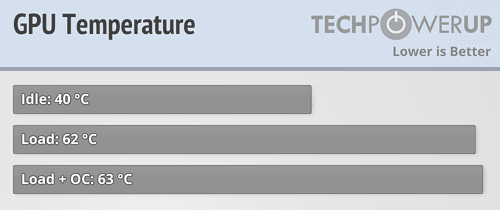 29
29
Gigabyte GTX 1060 Xtreme Gaming 6 GB Review
Value & Conclusion »Temperatures

Idle temperatures are excellent even with the fans turning off in idle. During gaming, the card also runs very cool and is quiet while doing so.
| GPU Temperature Comparison | |||
|---|---|---|---|
| Idle | Load | Gaming Noise | |
| Gigabyte GTX 1060 XtremeGaming | 40°C | 62°C | 28 dBA |
| ASUS GTX 1060 STRIX OC | 42°C | 63°C | 32 dBA |
| MSI GTX 1060 Gaming X 3 GB | 50°C | 67°C | 29 dBA |
| MSI GTX 1060 OC | 32°C | 71°C | 31 dBA |
| Palit GTX 1060 Super JetStream | 42°C | 74°C | 32 dBA |
| MSI GTX 1060 Gaming X | 50°C | 67°C | 28 dBA |
| NVIDIA GTX 1060 FE | 35°C | 77°C | 34 dBA |
cooler design, and production variances. This table just serves to provide a list of
typical temperatures for similar cards as determined during TPU review.
Clock Profiles
Modern graphics cards have several clock profiles that are selected to balance power draw and performance requirements.The following table lists the clock settings for important performance scenarios and the GPU voltage that is used in those states.
| GPU Clock | Memory Clock | GPU Voltage (measured) | |
|---|---|---|---|
| Desktop | 253 MHz | 203 MHz | 0.625 V |
| Multi-Monitor | 253 MHz | 203 MHz | 0.625 V |
| Blu-ray Playback | 253 MHz | 203 MHz | 0.625 V |
| 3D Load | 1620 - 2025 MHz | 2040 MHz | 0.790 - 1.080 V |
For the graph below, we recorded all GPU clock and GPU voltage combinations of our 1920x1080 resolution benchmarking suite. The plotted points are transparent, which allows them to add up to indicate more often used values. A light color means the clock/voltage combination is rarely used and a dark color means it's active more often.

May 4th, 2025 10:15 EDT
change timezone
Latest GPU Drivers
New Forum Posts
- Half Life 3 soon ? (0)
- Choosing an Internal HDD (57)
- Is RX 9070 VRAM temperature regular value or hotspot? (373)
- Windows 11 General Discussion (6011)
- Last game you purchased? (799)
- Are the 8 GB cards worth it? (817)
- Windows 12 (158)
- Have you got pie today? (16694)
- Old NVIDIA GPU with torn branding sticker - what’s the brand? (6)
- PSU chirping sound (5)
Popular Reviews
- Clair Obscur: Expedition 33 Performance Benchmark Review - 33 GPUs Tested
- ASUS ROG Maximus Z890 Hero Review
- ASUS Radeon RX 9070 XT TUF OC Review
- Montech HS02 PRO Review
- NVIDIA GeForce RTX 5060 Ti 8 GB Review - So Many Compromises
- ASUS GeForce RTX 5090 Astral Liquid OC Review - The Most Expensive GPU I've Ever Tested
- Seasonic Vertex GX 850 W Review
- Upcoming Hardware Launches 2025 (Updated Apr 2025)
- ASRock Radeon RX 9070 XT Taichi OC Review - Excellent Cooling
- Team Group GC Pro 2 TB Review
Controversial News Posts
- AMD Radeon RX 9060 XT to Roll Out 8 GB GDDR6 Edition, Despite Rumors (129)
- NVIDIA Sends MSRP Numbers to Partners: GeForce RTX 5060 Ti 8 GB at $379, RTX 5060 Ti 16 GB at $429 (128)
- NVIDIA Launches GeForce RTX 5060 Series, Beginning with RTX 5060 Ti This Week (115)
- Nintendo Confirms That Switch 2 Joy-Cons Will Not Utilize Hall Effect Stick Technology (105)
- NVIDIA PhysX and Flow Made Fully Open-Source (95)
- Sony Increases the PS5 Pricing in EMEA and ANZ by Around 25 Percent (84)
- Parts of NVIDIA GeForce RTX 50 Series GPU PCB Reach Over 100°C: Report (78)
- Intel "Bartlett Lake-S" Gaming CPU is Possible, More Hints Appear for a 12 P-Core SKU (77)